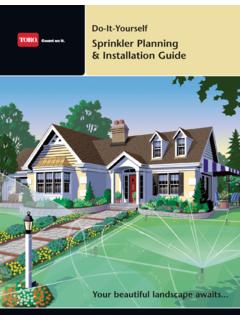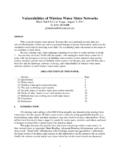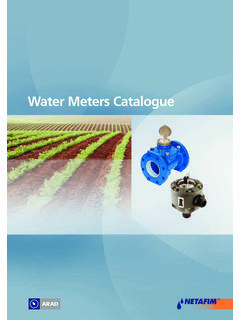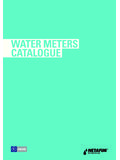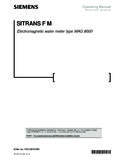Transcription of GUIDE TO WATER SUBMETERS - City of New York
1 CITY OF NEW YORK DEPARTMENT OF ENVIRONMENTAL PROTECTION GUIDE TO WATER SUBMETERS Produced in association with Intro 0268-2010 March 2013 Michael R. Bloomberg, Mayor Carter H. Strickland, Jr., Commissioner 1 Introduction This booklet is provided as technical information for the design professional, licensed plumber, or conservation professional as an introduction to WATER meter and meter communications technology. Additional information can be obtained from the manufacturer websites listed at the end of this document. The legislation passed by the New York City Council (Intro 0268-2010) does not include a requirement that SUBMETERS need to be approved in any form.
2 This booklet should not be viewed as an approved list but as a technical resource. Some of the meters listed in this booklet are qualified for use as DEP billing meters and others are not. Inclusion in this booklet does not mean that the meter is approved for DEP billing purposes, nor that the product is approved or endorsed by the city of New York. Please refer to the separate List of Approved WATER Meters available on the DEP website (Customer Service > Property Managers and Trade Professionals). This booklet will be updated approximately once a year. If you have questions, comments or suggestions about this list, write: Warren Liebold Bureau of Customer Services - Metering New York City Department of Environmental Protection 59-17 Junction Blvd.
3 - 1st Floor LR Flushing, NY 11373 A Few Abbreviations and Acronyms AMR Automated (or Automatic) Meter Reading. Use of a radio- or telephone-based transmitter to send meter readings a short or long distance to a receiver that may be mobile or fixed. DEP billing meters are read using an Aclara Star AMI system. Meter Body The base meter with internal measuring element Meter Register The portion of the meter mounted on the meter body, that totalizes and displays WATER use information About WATER Meters and Industry Standards WATER meters used by or Canadian WATER utilities must meet prescriptive and performance requirements set by the American WATER Works Association ( AWWA ).
4 Some European meters also comply with ISO 4064 where Class C and D in that system represent meters with utility grade accuracy. The ISO standard is more performance- rather than prescriptive-based. The city legislation does not prohibit the use of meters that do not meet either standard set but if you do use non-standard products there may be less assurance about accuracy, quality of construction and longevity of service. Some BTU meters are only covered by European standards that may be excellent but have no equivalent. Note on No Lead Alloys DEP WATER use rulesa require that all WATER meter bodies be composed of an alloy with no more than lead. The Council s bill has no such requirement for SUBMETERS but the design professional and licensed plumber may wish to avoid specifying a product that the owner may consider substandard from a health and safety perspective.
5 Plastic meter bodies comply and metal meter bodies that comply should be stamped or labeled NSF-61. Meter manufacturers may use more than one alloy to accomplish this purpose and the mention of a specific alloy in this document does not preclude a manufacturer from using another equal or superior alternative. Some manufacturers simply provide an epoxy coating over an old-type meter to attain compliance. Since some of the meters on this list are not DEP-approved the design professional needs to confirm that the product they use is NSF-61 Certified. Meter Types Most SUBMETERS used for building monitoring or cost allocation purposes will be positive displacement or single-jet types but some of the other technologies will be used for larger connections.
6 Positive displacement, or disc meters The primary design used in most small residential and commercial applications due to reliability and low cost. Available in through 2 sizes. The 1 and 2 versions do not register very precisely at flow rates below gpm. Positive displacement meters can be installed on inclined and even vertical pipe. Some manufacturers have versions designed for hot WATER . The smaller versions can often operate for more than a decade with only modest deterioration of accuracy. These meters have internal strainers (screens). There are at least five (5) manufacturers. Positive displacement meters should not be used on branches with fire protection sprinklers.
7 Single-Jet Meters This design is often directed at either applications with a need for accuracy at low flow rates (under 2 gpm) or limited space since they are physically smaller than positive displacement meters. They are considerably more expensive than positive displacement or multi-jet meters. They must be installed on a level horizontal plane (+/- 10%) to operate accurately. There is currently only one manufacturer of small single-jet meters, Metron-Farnier. Their meters are rated for hot WATER service up to 140 degrees. They are available in through 6 sizes. Multi-Jet Meters This meter design has traditionally been popular with utilities that have suspended matter or grit in their WATER since it is more tolerant of that material than positive displacement meters.
8 They do not remain as accurate as positive displacement meters over the long term. They must be installed in a level horizontal plane. This class of meter has never been approved for billing purposes by DEP. They are available in through 2 sizes. Oscillating flow meters One manufacturer (Elster) produces an oscillating flow meter with an electronic register in and 1 sizes that claims to operate with high accuracy for 20 years or longer. Turbine meters Available in 2 and larger sizes, these are inferential meters designed for high flow rates. Electromagnetic meters Manufactured by several companies in sizes 1 and larger, these meters have no moving parts and operate on Faraday s Principle.
9 BTU Meters More a functional group rather than a technological type, these are meters that measure both flow and heat content (not just temperature) and at least for now are far more common in Europe which defines their standards. The can be single-jet, turbine or other types. Units of Measurement Most WATER utilities have WATER meters that measure in cubic feet with billing in hundreds of cubic feet. Almost all meter manufacturers also supply units that register in gallons. Be sure to specify gallons if that is what you want. gallons = 1 cubic foot. 3 Meter Registers: Different Ways to Obtain a Remote Reading All meters can be read directly by viewing the odometer-type display on the meter.
10 Some have slightly different layouts, and standardizing to one manufacturer may have some advantages. Transmission of data to a remote location or to a remote computer of some kind requires some thought. Absolute Encoders Most American and Canadian WATER utilities use meters with registers that are absolute encoders. What this means is that a specialized meter reading handheld computer, or an AMR box is wired to the meter register and that device sends a very low voltage signal into the register. The register returns an actual read by detecting the the current positions of the odometer-type wheels. Most meters do this through a combination of chips and mechanical sensors or markers on the odometer wheels (physical encoders) while some newer versions use optical pickups (optical encoders).











